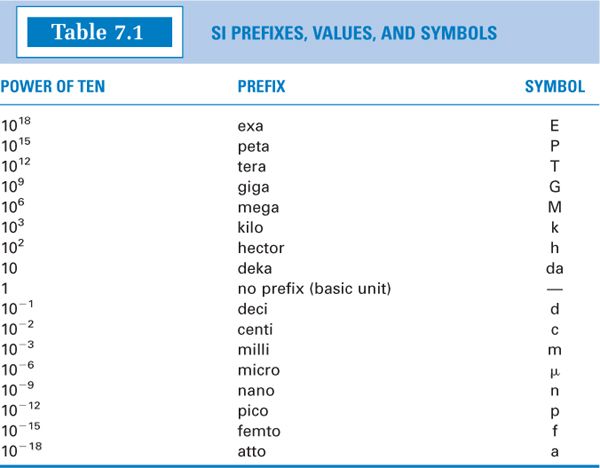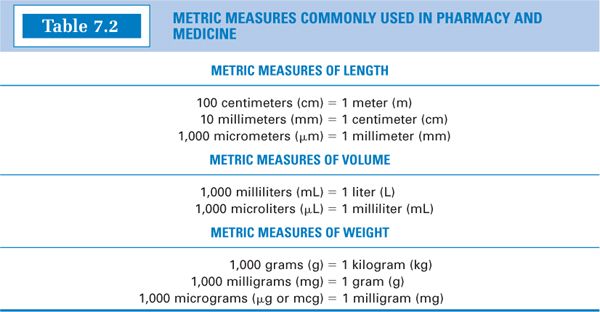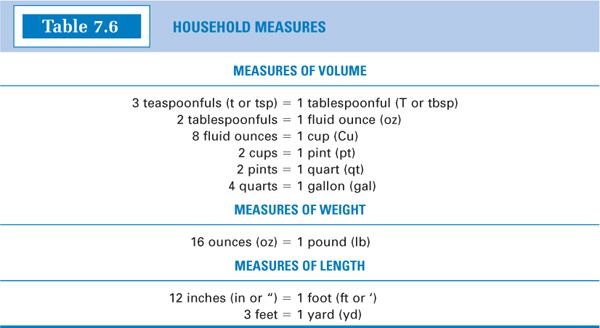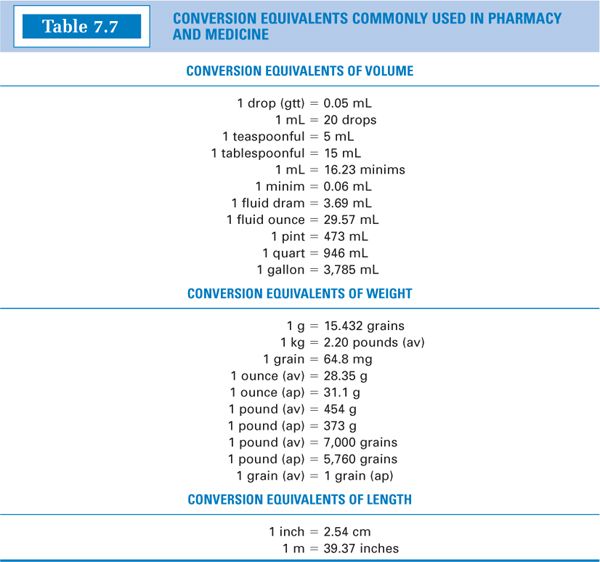OUTLINE
Intersystem Conversion for Weights and Volumes
Temperature Conversions and Calculation of Mean Kinetic Temperature
Methods for Pharmaceutical Calculations
I. SYSTEMS OF MEASUREMENT
Three systems of measurement are currently used in the United States: the metric or International System of Units (SI), the apothecaries’ system, and the avoirdupois system. The SI or metric system is now the only system of measurement acceptable for use in pharmacy and medicine, but since both the apothecaries’ and avoirdupois systems (sometimes called the common or customary systems) are used both in commerce and daily life activities, pharmacists and pharmacy technicians must be knowledgeable about all three systems. The discussion here gives a summary of the various systems; for a more detailed treatment, consult the chapter on metrology in Remington: The Science and Practice of Pharmacy and the guidebook and Internet Web sites referenced below.
A. Metric or International System of Units (SI)
1. The metric system was formalized in France in the late 1700s. It employs a decimal system that is both logical and easy to use. It was adopted as a legal system (although not a mandatory one) in the United States in 1866. At this time, rapid scientific and industrial development was taking place, and it became apparent that a standardized, internationally recognized system of measurement was needed. In 1875, the United States joined 20 other countries in signing the Treaty of the Meter, which adopted the metric system and established the International Bureau of Weights and Measures to work internationally to advance and maintain the system (1,2).
2. The original basic units of the metric system were the meter for length and the kilogram for mass. For many years, the reference standard for the meter was a platinum–iridium bar with etch marks delineating a meter; a 1-kg platinum–iridium block was used as the standard for mass. The originals were kept in a vault at the International Bureau headquarters in France, and each of the treaty member countries received two copies of the standards. The reference standards for these basic units have changed over the years as technology has advanced. Standards were desired that were based on unchanging physical characteristics of specified elements. Currently, the meter is defined as “the length of the path traveled by light in a vacuum during the time interval of 1/299,792,458 of a second” (3), with a second equivalent to 9,129,631,770 oscillations of the 133Cs atom (2).
3. In 1960, the metric system was refined and the International System of Units (SI) was adopted. The initial basic units of the metric system are the same in SI, but some units were added or updated and some of the symbols and notation were slightly changed and were standardized. There are seven basic units in SI: the meter (m) for length, the kilogram (kg) for mass, the second(s) for time, the mole (mol) for amount of substance, the kelvin (K) for thermodynamic temperature, the ampere (A) for electric current, and the candela (cd) for luminous intensity (4). The international group in charge of SI is still located in France and is now called the Conference Generale des Poids et Mesures, or CGPM; the United States is represented on this body by the National Institute of Standards & Technology (NIST), an arm of the U.S. Department of Commerce (4). All the symbols, special names, and formulas for the basic, supplementary, and derived SI units are listed in the miscellaneous tables section of The Merck Index. These lists and other useful information on SI can be found in the book Guide to the Use of the Metric System [SI Version], which is available from the U.S. Metric Association through its Internet site (5).
4. In pharmacy and medicine, we most often need to measure or use units of length, mass, and volume.
a. As stated previously, the basic unit of length in SI is the meter, although in pharmacy we more often use the centimeter, which is 0.01 meter (that is, 1/100 of a meter).
b. The basic unit of volume in SI is the cubic meter (m3), but the liter (L), although not an SI unit, is approved for use in SI for measuring liquid volume. The liter is the fundamental unit of volume used in pharmacy and medicine; it is essentially the volume of 1,000 cubic centimeters (cm3). You will sometimes see the abbreviation “cc” used for cubic centimeter, but this notation does not follow SI conventions. Furthermore, it has been the source of medication errors (see Table 1.1 in Chapter 1) and should not be used.
c. Although the official basic unit of mass in SI is the kilogram, the gram (g) has been used as the basic stem unit (see later). One gram is the mass of 1 cm3 of water at 4°C. Because 1 mL (1 mL = 0.001 L) is equal to 1 cm3, 1 mL of water also has a mass of 1 g. [Note that kilograms and grams are units of mass (not weight), even though in practice we usually use the term weight when we actually mean mass. In this text, we will use the terms weight and mass interchangeably, although technically weight is a measure of force and is mass times gravitational acceleration.]
d. Other metric units of length, volume, and weight are achieved by applying prefixes to an appropriate stem unit: meter (m), liter (L), or gram (g). The prefix specifies a power of ten that is multiplied by the stem unit. For example, the prefix milli (m) is associated with a 10−3 multiple, so that a millimeter (mm) is 10−3 meters, a milligram (mg) is 10−3 grams, and a milliliter (mL) is 10−3 liters. Prefixes for SI units, together with their associated powers of ten and their symbols, are given in Table 7.1. Note that the letter case, capital (upper-case) letter or lowercase letter, is important; lowercase m for milli signifies 10−3, whereas uppercase M for mega designates 106—a huge difference! Uppercase letters are used for symbols indicating powers of 106 and higher. Also note that, while the SI symbol for micro is the lowercase Greek letter mu (μ), this symbol should not be used when expressing doses (e.g., use mcg instead of μg), because μg can easily be misread as mg (see Table 1.1 in Chapter 1).
e. Metric units of length, volume, and weight most commonly used in pharmacy and medicine are given in Table 7.2. In older scientific literature, you may see the unit of length, the angstrom, which uses the symbol Å; 1 Å = 10−10 m.
5. The U.S. Metric Association maintains an Internet site that contains information on correct usage of the SI-metric system; their Guide to the Use of the Metric System [SI Version] has even more complete information (4,5). Some of the basic rules are listed here, and the correct format for some of the symbols commonly used in pharmacy and medicine are listed in Table 7.3 (4,5).
a. The short forms for the dimension units, such as “cm” for centimeter, are called symbols rather than abbreviations.
b. There should always be a space between the numeric digits of a quantity and its SI symbol (e.g., “5 g” rather than “5g”).
c. The symbols are never followed by periods unless a symbol is at the end of a sentence.
d. Symbols are always written in singular form but, when the word for a unit is used, the plural form is used when appropriate. For example, write “5 mL” (not “5 mLs”), but write “5 milliliters.”
e. When a symbol is a compound unit, and it is a quotient of two units, that quotient may be designated with a solidus (forward slash mark, “/”) or a negative exponent (e.g., g/cm3 or g cm−3). The letter “p” is not to be used for the word per, but per may be written out (e.g., 5 milligrams per milliliter). (Note: In pharmacy and medicine, when writing dose concentrations, the use of the solidus is not recommended because of medication errors that have resulted from reading it as a number one. In this text, the word per is used in place of the solidus in these circumstances.)
f. As noted earlier in the example of milli (m) and mega (M), letter case is important. Some of the SI rules with regard to letter case are given here.
(1) Metric unit names (such as gram, meter, kelvin) are not capitalized (unless, of course, the name is at the beginning of a sentence), even though some units, such as the basic unit kelvin and derived units such as the newton (for force) and the pascal (for pressure), are named for persons. The exception is Celsius, which is always capitalized.
(2) Most metric symbols are also lowercase letters (e.g., g and m); however, in contrast to metric unit names, those symbols that are named after persons have uppercase letters (for example, the symbol for newton is N, for pascal is Pa, and for kelvin is K).
(3) Notice in Table 7.3 that the symbol for liter may be either upper- or lowercase el (L or l, mL or ml); uppercase L is preferred in the United States, Canada, and Australia, while the lowercase letter is used in most other countries.
6. Italics are not to be used for metric symbols (e.g., 5 g, not 5 g). This is because italics are often used to designate measurements in mathematical formulas: For example, in the formulas for density and specific gravity shown later in this chapter, the m stands for mass, not meter.
7. Both from a patient safety viewpoint and to correctly convey information about quantities, it is important to know and use correct and current SI symbols. Two examples may help to illustrate this: At one time the abbreviation “Gm” was sometimes used as a symbol for gram, but under SI this is the symbol for gigameter; the abbreviation “gr” has sometimes been mistakenly used or misinterpreted to mean gram, but it is the symbol for the apothecaries’/avoirdupois grain, which equals 64.8 mg. The lowercase g without a period is the only acceptable symbol for gram. It is essential that all health care personnel know and use precisely the correct SI symbols.
B. Avoirdupois System
1. The avoirdupois system is the common or customary system of weights used in commerce and households in the United States. Although the U.S. government has strongly encouraged conversion to the metric system (called metrication), it has been an uphill battle to get industry and the population to use and think in terms of SI or metric units. We still measure and give our body weight in terms of pounds, buy butter and meat by the pound and pasta and cereal by the ounce, and have postage for letters and packages calculated based on ounces and pounds.
2. The basic units of mass for the avoirdupois system are the grain, the ounce, and the pound. The avoirdupois grain has the same mass as the apothecaries’ system grain (see section C, Apothecaries’ System), but both the ounce and the pound are different in the two systems.
3. In the United Kingdom, Canada, and some other commonwealth countries, the British Imperial system of mass is still sometimes used. For grains, ounces, and pounds, these are the same as those comparable units in the avoirdupois system.
4. The exact conversion for mass between the metric and avoirdupois systems is 1 pound = 453.59237 grams. See Tables 7.4 and 7.7 for other equivalents and conversion factors. In Table 7.7, the designation (av) following an avoirdupois unit is used to distinguish it from the similar, but not equal, apothecaries’ unit.
C. Apothecaries’ System
1. Apothecaries’ weight
a. The apothecaries’ system for mass is used only in pharmacy and medicine. While the use of this system of measurement is strongly discouraged, some older compounding formulas are written using the apothecaries’ system, so it is important to know about it and understand how to convert apothecaries’ quantities to metric equivalents.
b. The units of mass for the apothecaries’ system are the grain, the scruple, the dram (formerly spelled drachm), the ounce, and the pound. As stated previously, only the grain has the same mass in both the apothecaries’ and avoirdupois systems (and in the British Imperial system). See Tables 7.5 and 7.7 for apothecaries’ equivalents and conversion factors. In Table 7.7, the designation (ap) following an apothecaries’ unit is used to distinguish it from the similar, but not equal, avoirdupois unit.
2. Apothecaries’ liquid volume
a. The apothecaries’ system for liquid measurement is the common system for commerce and household use in the United States. As with the apothecaries’ system of weights, it was formerly used for prescriptions and compounding formulas. It is no longer an official system for medicine and pharmacy, and its use is strongly discouraged.
b. The units of volume for this system include the minim, the fluid dram and fluid ounce, the pint, the quart, and the gallon. See Tables 7.5 and 7.7 for the various units of measurement and equivalents.
c. The British Imperial system of volume uses the same unit names, but these represent different quantities. Consult an appropriate reference for conversion factors if using a formula based on the British system.
D. Household and other measure
1. The units of measurement used in the United States for cooking and daily life is a conglomerate from the avoirdupois system of weights, the apothecaries’ system of volume, and a hodgepodge of drops, teaspoons, tablespoons, quarts, inches, feet, yards, and so on. See Table 7.6 for household measures and Table 7.7 for conversion equivalents.
2. Because the teaspoon is so commonly used in the home to measure liquid medications, the USP has a general chapter to address this volume. Chapter 〈1221〉 Teaspoon states that although an American Standard Teaspoon has been established by the American National Standards Institute as containing 4.93 ± 0.24 mL, for household use this volume is taken to be 5 mL. Chapter 〈1221〉 directs that liquid medications formulated for oral administration by teaspoon be made on the basis of 5-mL units (6). Therefore, for purposes of dispensing medication, one teaspoonful is taken to mean 5 mL.
3. In USP Chapter 〈1101〉 Medicine Dropper, a Pharmacopeial medicine dropper is described; the specifications state that the tip delivers between 45 mg and 55 mg of water per drop (7). Using the average of 50 mg/drop, and the density of water of 1 g/mL, this would give 20 drops/mL or 0.05 mL/drop. The USP chapter notes that other liquids have viscosities and surface tensions that are different from water; therefore, the same dropper would give different quantities per drop for these other liquids (7). The section on volumetric apparatus in Chapter 14 of this book describes the procedure needed to calibrate a medicine dropper before using it as a dosing device. Fortunately, we now have better and more accurate measuring devices to use or dispense with liquid medications for measuring doses.
4. At one time, it was common practice for physicians and nurses to use apothecaries’ fluid volume symbols as “abbreviations” for common measurements when writing the directions-foruse portion of a prescription or medication order. This practice is now strongly discouraged, both because the apothecaries’ system is now considered obsolete and because such symbols with dual meanings are so prone to misinterpretation and error.
a. Although a fluid dram contains only 3.69 mL, some prescribers formerly used the dram symbol (3) as an abbreviation for a teaspoonful, which is 5 mL.
b. Although a USP drop is 0.05 mL, some nurses use the minim symbol (m) as an abbreviation for drop. A minim is 0.06 mL.
c. Even more hazardous was the use of the apothecary ounce symbol (3) as an abbreviation for 30 mL or two tablespoonfuls, and the apothecary symbol for one-half ounce (3ss) as an abbreviation for 15 mL or 1 tablespoonful. In this case, pharmacists and physicians have mistakenly used or interpreted the (3) symbol as an abbreviation for 1 tablespoonful, giving a dose that was either one-half or double that which was intended.
II. INTERSYSTEM CONVERSION FOR WEIGHTS AND VOLUMES
Stay updated, free articles. Join our Telegram channel

Full access? Get Clinical Tree









